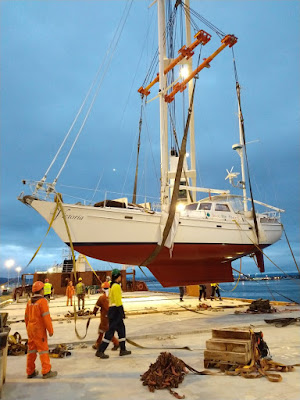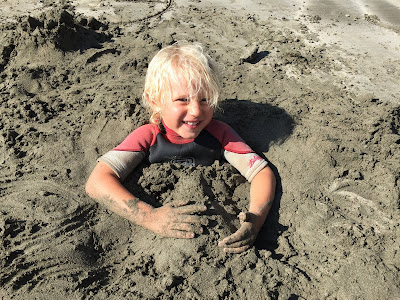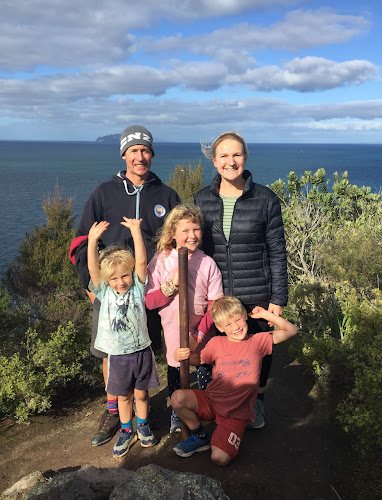A delayed departure and how to follow us at sea
 |
| The view from the top of the mast - Angus doing our pre-departure rig checks |
When our friend Brett was on board, he introduced us to the
phrase “shooting for the Tongas”. We
laughed so much at him, as he’s the only person we’ve ever heard who refers to
the Kingdom of Tonga as “the Tongas”, but the phrase has stuck, and the time is
approaching. We thought we only had one
more flat boat sleep before we shoot for the Tongas, but actually there’s a bit
of weather north of here, which could turn into a named tropical storm, so we’re
staying put for a few more days at least.
We’ve been alongside a pontoon in Opua, on the north-east coast of the north
island, for the past week, and have been rushing around chasing our tails with our
final preparations before we head offshore.
The great news is that our UK Ship Registration finally came through, so
we are now legal to depart New Zealand when the time comes.
 |
| A few tweaks to our rig tension.. |
We’ve joined a rally called the Island Cruising New Zealand
Pacific Circuit Rally, along with about 40 other boats, so we won’t be on our
own for the crossing to Tonga. It has
been a fascinating week meeting the other people and beginning to get to know
them. There are lots of “kid boats” in
the fleet. With 25 children on the
rally, from 10 months old to teenagers, our three have loved getting to know
their new buddies. There’s one boat with
four boys, aged 2, 4, 6 and 8!! Whenever
things are getting a bit crazy on the good ship Vicky, we just imagine how it
must be on that boat, and feel instantly better. The majority of the rally people are not on “kid
boats”, but to be honest we haven’t seen much of them, as they are not refereeing
their offspring at children’s hour each day, and during the weather / routing /
passage planning talks, the real grown-ups are able to sit at the front and concentrate,
whereas we are hovering by the doors to the decking, keeping a look-out for
children scaling the Opua Cruising Club balcony and contemplating a quick dip
in the sea below…
 |
| Eloise and George getting involved in the SUP demonstration |
At the beginning of the week, we were feeling pretty relaxed
about crossing an ocean with children.
Afterall, lots of other people are doing the same as us, some with more
children, others with manically crazy toddlers, and a few having almost never
sailed before. (And that’s not just the
children..) As the week has progressed,
however, it has come to light that most of the mothers and children are flying
to Tonga, leaving their husbands to sail the passage with at least two or three
additional crew. Where the children are doing
the passage, the families all have a minimum of one extra adult with them. There are lots of adverts up in the laundry here
at the marina, of smiling young people wanting “the experience” of crewing on a
boat to Tonga. We have considered it,
but on balance we don’t feel anyone is ready for “the experience” of Jack in a
confined space for a week, and also it seems a bit of a risk having an unknown
person join the boat, so we have decided we are better to stick as the family
unit. Having said that, George was
reading the “RYA Sea Survival Handbook” at breakfast today, and Eloise had picked
up and was ploughing through “Single-handed sailing”, so I’m not sure they have a huge amount of faith in our sailing ability.
 |
| Our salty shipmates with our lovely flat - thank you Sophie and Rory xx |
A very chatty American couple were strolling along our pontoon
yesterday, and stopped to ask me and Jack about our boat and our trip. “Wow, gee..
and whatta you do at night?” the lady asked.
“Ah, at night. Well, we just put
down our sea anchor and go to sleep,” I replied. “Reeeeaaaally?” she asked, wide-eyed. I laughed, shook my head, and explained how
things work at once the sun has gone down.
The kids snuggle down in their beds, rocked to sleep by the motion, not a care in the world, while Angus
and I take turns between sleeping rather fitfully, and struggling to keep our eyes open on-watch and keep the boat
sailing safely along at best speed in the right direction. We did a night passage last
week, on our way north, as part of our preparation on Victoria. We up-anchored at Great Barrier Island at 5pm,
just before it got dark, and lovely Eloise rustled up macaroni cheese for our hungry
crew, while Angus got the sails up as we cleared the land. We sailed through the night to arrive in the
Bay of Islands the following day. The
night was beautiful. We had a lovely
breeze, the sky was awash with stars, and the most extraordinary thing was that
we only saw one other boat on the whole passage. Last summer we crossed the English Channel at
night, and hardly got a wink of sleep due to the volume of ships and fishing
boats, all intent on mowing us down. The
waters of New Zealand are notably more relaxing to sail in, although the wind
angle was not great and we were struggling to keep away from the land, so eventually
we gave up the battle and turned on the engine for a while.
 |
| Ashore in Great Barrier Island - just before the children found some long-lost treasure |
Once everyone else was finally asleep, Angus and I split
the remainder of the night into short watches - two-hours-on, two-hours-off. It went well and we both got a bit of sleep,
but it’s fair to say that the following night, when we were safely anchored in
a lovely bay, we were absolutely shattered!!
Our plan for the offshore passage is to split the night into longer watches,
so that we get a few more hours of solid sleep, and also to make sure we both
get a nap of a couple of hours in the day.
I’m not actually sure how this will be possible with the children, and sailing
the boat, but if it’s not we’ll just have to man up, deploy some cocktail sticks to keep our eyes open, and have a really good sleep
when we get to Tonga.
 |
| Jack sitting on the fridge, helping me make scrambled eggs |
We are gearing up for the change in our on board communications
while we are at sea. Obviously, our
mobile phones won’t work offshore, and we won’t have wifi. Instead we will use radios; normal VHF radio,
which works up to about 20-30 miles, and long range radio, or SSB (single side
band). Once we have connected our boat
computer and fired up the modem, the SSB is capable of connecting to coastal
stations to receive emails to our boat email address, and more importantly,
weather files, to our boat computer.
This is quite an art and requires a good deal of patience; a successful
connection to a coastal radio station (“Darawank” is the usual one) is
dependent upon time of day, weather conditions, sun spots (?!) and tussling
with whoever else is trying to connect at the same time. Almost all of the other boats we are going
with have satellite phones for sending and receiving emails, which is much more
of an investment, and seems to take away some of the romance of being at
sea. Let’s see how long we can hold out
before we take the easy (but pricey) option and adopt the more modern
technology!
 |
| Model boat building - hours of fun (but we now need to resupply on spinnaker repair cloth and tape).. |
The Island Cruising New Zealand rally has a tracking page:
The boats with satellite communications will have their
positions updated continuously, whereas we have to email ours via the long range
radio for it to be updated. So - just to
warn you - we won’t actually move very often on the tracker – probably once or twice
a day. Please don’t be disheartened or
worry about us if we are stationary for ages, because a) it is not a race and b) every time we manage to email
an updated position we will make a huge and impossibly fast leap forwards. Sometimes things can get very busy on a boat –
we might be making delicious muffins, or landing a huge fish, or be engrossed
in home-schooling, or clearing up something that has crashed all over the floor,
or in the middle of changing our sail plan – in which case connecting the computer
and firing up the SSB to send our position may take second place.
 |
| Ten snapper in two hours - with a little help from our friends the Renalls on Calypso.. |
For any boaties (NZ terminology) who have an AIS app – eg marinetraffic.com, then you
should be able to follow us on that too, once we are at sea and have ours turned
on. Our boat is Victoria, call sign
MEWK3, MMSI 232 020 973.
If you just want to see the odd picture, do follow us on Instagram.
We will send some updates from the high seas which my
sister, Rosie, will post to the blog (so long as we can both manage the technology), so
we should be able to share some salty tales while we are en route to Tonga. In case we fail on this quest, Eloise highly recommends the School Ship Tobermory Series, by Alexander McCall Smith, to give a flavour of life on board a boat at sea. She devoured the whole lot in a few days, and we have also all enjoyed and learned a few things from the Bear Grylls adventures books; the Sailing Challenge and the Sea Challenge.
 |
| A long-awaited bath! |
There’s so much more I would like to write about, but it’s very
late and we have a mass of things still to do.
It’s probably fortunate that our departure has been delayed. We need to tidy and stow the whole boat, buy
our fresh fruit and veg for the passage, check that the deck and all our lines
are ready for sea, tie on our kayaks and dinghy very securely, move the boys
bedding out of their cabin (which is at the front, so too bouncy to sleep in at
sea), plus restarting home school tomorrow, which rather fell by the wayside
last week with all the frantic preparation.
Most crews by this stage are either in a similar state of chaos to us, or are completely
stowed and organised, and are now reading their books and watching movies whilst baking brownies and
preparing stews to eat en route. If only that was us! We
haven’t done a detailed passage plan yet, but Angus has done an incredible job in
making sure we have all the right paper charts, plus downloading not only two separate sets of electronic charts on a variety of devices, but also satellite images from google earth and Bing, which
we can compare to the paper and electronic charts. In the part of the world we are going to,
there is a lot of underwater volcanic activity, not to mention moving and
growing coral heads, so a satellite image can be an extremely useful thing to
have, along with a depth sounder and several good pairs of eyes, of course.
 |
| Eloise's plaits kept falling out, so we superglued the ends! |
It feels like a little bit of an anti-climax that we’re not leaving tomorrow, but we don’t really want to find ourselves a couple of days from Tonga in a tropical rotating storm with 4-6 metre waves, which is a possibility based on current predictions, so we’re more than happy to spend a few more days in New Zealand. If you want to have a look at a real-time snapshot of what the weather is doing all over the world right now, we absolutely love the earth.nullschool website. This link, depending on how soon you look at it, will show a cheeky little low pressure system north of Fiji, which is the one the weather gurus have their eye on as being potentially troublesome.
 |
| Another cheeky little thing which is potentially troublesome..! Darling Jack doing a bit of early morning window cleaning. |
I’ll send another quick update before we depart.
Lots of love from all of us salty sea dogs.
Laura, Angus, Eloise, George and Jack xxx
 |
| We loved catching up with our Winchester friends, the Davidsons They left Opua last week bound for Fiji on their lovely boat, Bonaire |



Great updates. Super excited for you getting set to leave for Tonga. Hi to Angus, would be great to 'hear' a few words from him about his take on the preparations if he gets a chance.. Good luck with the weather and your sail away date :-)
ReplyDelete